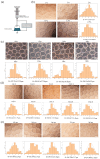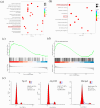Construction of Microsphere Culture System for Human Mesenchymal Stem Cell Aggregates
- PMID: 40650211
- PMCID: PMC12250013
- DOI: 10.3390/ijms26136435
Construction of Microsphere Culture System for Human Mesenchymal Stem Cell Aggregates
Abstract
Stem cells cultured in cell aggregates exhibit higher cell survival rates and enhanced anti-inflammatory and angiogenic effects compared to single cells, constructing a stable and economical cell aggregate culture system that can accurately adjust the mass transfer distance of nutrients, which contributes to improving the therapeutic effects of stem cell aggregates. In this study, an alginate hydrogel microsphere culture system (Alg-HM) was prepared using electrostatic spraying technology and refined by optimizing the electrostatic spraying technology parameters, such as the sodium alginate concentration, voltage, electrospray injection speed, and nozzle inner diameter. Furthermore, by setting the Tip-dropped culture system (Tip-D culture system, created by dropping the resuspended hMSC aggregate-hydrogel solution with a tip to form the hydrogel microsphere) and Matrigel culture system (created by dropping the resuspended hMSC aggregates-Matrigel solution with a tip to form the Matrigel culture system) as the control group and Alg-HM as the experimental group, the culture effect of hMSC aggregates in the optimized Alg-HM culture system was tested; CCK-8 detection and Ki-67 immunofluorescence staining showed that the Alg-HM culture system significantly enhanced the cell proliferation activity of hMSC aggregates after 7 and 14 days of culture. The Calcein-AM/PI cell staining results showed that the Alg-HM culture system can significantly reduce the central necrosis of hMSC aggregates. The RNA sequencing results showed that the Alg-HM culture system can significantly activate the signaling pathways related to cell proliferation in hMSCs. This culture system is helpful for the culture of cell aggregates in vitro and efficient transplantation in vivo.
Keywords: alginate hydrogel; cell aggregate; electrostatic spraying technology; mesenchymal stem cells.
Conflict of interest statement
The authors declare no conflicts of interest.
Figures





Similar articles
-
One-Step Surface Functionalization of Hydrogel-Based, Stimulus-Responsive 3D Microstructures for Human Stem Cells.ACS Appl Mater Interfaces. 2025 Jun 18;17(24):35316-35327. doi: 10.1021/acsami.5c08146. Epub 2025 Jun 5. ACS Appl Mater Interfaces. 2025. PMID: 40470977
-
Unraveling the role of shell hydrophilicity of core-shell microspheres on fibroblast cell bioactivity as biostimulators.Int J Pharm. 2025 Aug 20;681:125815. doi: 10.1016/j.ijpharm.2025.125815. Epub 2025 Jun 4. Int J Pharm. 2025. PMID: 40480296
-
Three-dimensional cell culture-derived extracellular vesicles loaded alginate/hyaluronic acid composite scaffold as an optimal therapy for cartilage defect regeneration.Biomed Mater. 2025 Feb 13;20(2). doi: 10.1088/1748-605X/adb22e. Biomed Mater. 2025. PMID: 39904054
-
Management of urinary stones by experts in stone disease (ESD 2025).Arch Ital Urol Androl. 2025 Jun 30;97(2):14085. doi: 10.4081/aiua.2025.14085. Epub 2025 Jun 30. Arch Ital Urol Androl. 2025. PMID: 40583613 Review.
-
Hydrogel dressings for venous leg ulcers.Cochrane Database Syst Rev. 2022 Aug 5;8(8):CD010738. doi: 10.1002/14651858.CD010738.pub2. Cochrane Database Syst Rev. 2022. PMID: 35930364 Free PMC article.
References
-
- Song Y.C., Park G.T., Moon H.J., Choi E.B., Lim M.J., Yoon J.W., Lee N., Kwon S.M., Lee B.J., Kim J.H. Hybrid spheroids containing mesenchymal stem cells promote therapeutic angiogenesis by increasing engraftment of co-transplanted endothelial colony-forming cells in vivo. Stem Cell Res. Ther. 2023;14:193. doi: 10.1186/s13287-023-03435-z. - DOI - PMC - PubMed
-
- Shimazawa Y., Kusamori K., Tsujimura M., Shimomura A., Takasaki R., Takayama Y., Shimizu K., Konishi S., Nishikawa M. Intravenous injection of mesenchymal stem cell spheroids improves the pulmonary delivery and prolongs in vivo survival. Biotechnol. J. 2022;17:e2100137. doi: 10.1002/biot.202100137. - DOI - PubMed
MeSH terms
Substances
Grants and funding
LinkOut - more resources
Full Text Sources
Research Materials
Miscellaneous

